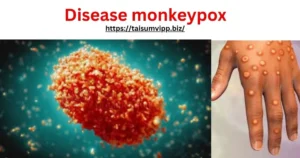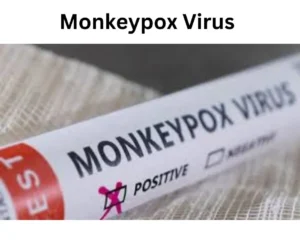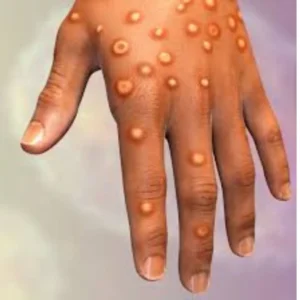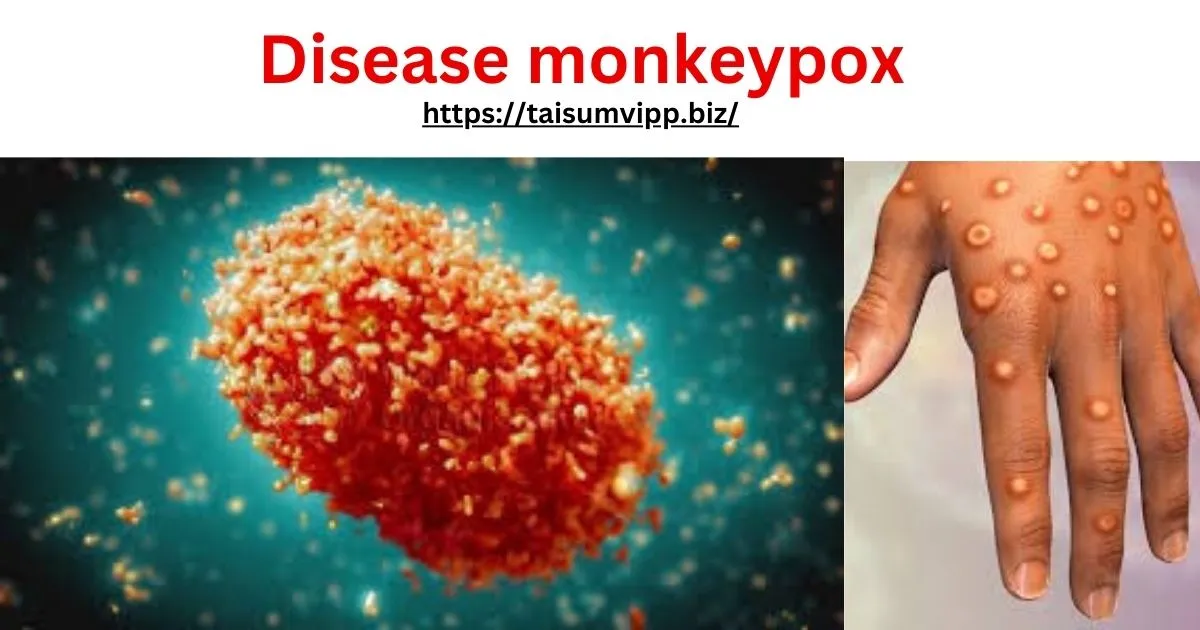Monkeypox is a highly contagious viral disease that belongs to the family of smallpox and cowpox viruses. Although rare, it can cause significant health concerns if left untreated. In this article, we will explore the symptoms of disease, its transmission, available treatments, and preventive measures to protect yourself and others.
Symptoms of Monkeypox
When a person becomes infected with monkeypox, they typically develop a range of symptoms within 1 to 2 weeks. These symptoms often start with fever, headache, muscle aches, and fatigue. Subsequently, a rash begins to appear, initially as small, raised bumps that develop into fluid-filled blisters.

The rash commonly starts on the face and then spreads to other parts of the body. As the blisters progress, they become pustules, which eventually form a crust and then scab over. Along with the rash, swollen lymph nodes and body aches may also be experienced.
It is important to note that is a rare viral disease that belongs to the same family of viruses as smallpox. The virus is primarily transmitted to humans from animals, with rodents being the most common carriers. While human-to-human transmission is possible, it is limited, usually occurring through respiratory droplets or contact with infected bodily fluids.
Due to the similarities between and smallpox, diagnosis can be challenging and requires specialized laboratory testing. Treatment for monkey pox symptom is primarily supportive, focusing on alleviating symptoms such as fever and pain. In severe cases, antiviral medications may be considered to help manage the infection.
Monkeypox Symptoms
Monkeypox symptoms can vary from person to person, with some individuals experiencing a mild illness and others developing more severe complications. In severe cases, the rash can cover the entire body and become deeply embedded, leading to scarring.
In addition to the physical symptoms, it can also affect a person’s mental state. It is not uncommon for individuals to experience feelings of anxiety, depression, or confusion during the course of the illness.
It is worth noting that is typically less severe than smallpox, which is fortunate as smallpox has been eradicated from the world through successful vaccination efforts.
One of the key distinguishing features of is the presence of swollen lymph nodes, which can be painful and tender to the touch. These swollen lymph nodes are a result of the body’s immune response to the virus, as it tries to contain and eliminate the infection.
Another common symptom of is the development of pustules or fluid-filled blisters on the skin, which can be itchy and uncomfortable. These pustules can vary in size and may contain a thick, yellowish fluid.
It is important for individuals experiencing symptoms of to seek medical attention promptly, as early detection and treatment can help alleviate the severity of the illness and prevent complications.
Monkeypox virus, a rare but potentially serious zoonotic disease, belongs to the Orthopoxvirus genus and was first discovered in laboratory monkeys in 1958. The virus is endemic to Central and West African countries, where sporadic outbreaks have been reported among both animals and humans.
While the primary reservoir of is believed to be wild animals, including non-human primates and rodents, the exact mechanism of transmission to humans is not yet fully understood.In addition to direct contact with infected animals, such as handling their carcasses or being bitten or scratched, individuals can also be exposed to the virus through consumption of undercooked meat from infected animals.
Furthermore, the risk of contracting is heightened in areas with limited access to healthcare and poor sanitation practices, as this can facilitate the spread of the virus within communities. It is crucial for healthcare providers in endemic regions to remain vigilant for any suspected cases of in order to promptly implement control measures and prevent potential outbreaks from escalating.
What Is Monkeypox?
Monkeypox, characterized by its similarities to smallpox, is an infectious disease caused by the virus. It was first identified in 1958 when outbreaks occurred in colonies of monkeys kept for research purposes. Since then, sporadic cases have been reported in humans mainly in Central and West African countries.

Although is rarely encountered outside of Africa, there have been instances of the virus appearing in other regions, including the United States and Europe, due to the global travel and trade.
It typically starts with flu-like symptoms such as fever, headache, muscle aches, and exhaustion. This initial phase is often followed by the development of a rash, which usually begins on the face and then spreads to other parts of the body. The rash evolves into raised bumps that fill with fluid and eventually crust over.
One of the key differences between monkeypox and smallpox is the mortality rate. While smallpox has a mortality rate of around 30%, is generally less severe, with a mortality rate of about 1-10%. However, severe cases of can still occur, especially in individuals with weakened immune systems.
Monkeypox Treatment
Currently, there is no specific antiviral treatment available. However, medical care focuses on managing symptoms and preventing complications. Supportive measures like adequate hydration, pain relief, and infection control are essential for patient care.
Good hygiene practices, including frequent handwashing and avoiding close contact with infected individuals or animals, are crucial to preventing the spread of the virus. Isolation precautions may be necessary in healthcare settings to minimize the risk of transmission.
Furthermore, in severe cases of where patients develop complications such as pneumonia or sepsis, intensive care support may be required. This can include mechanical ventilation to support breathing, intravenous fluids to maintain hydration, and close monitoring of vital signs to ensure stability.
Research into potential antiviral medications for is ongoing, with scientists exploring various compounds that may inhibit viral replication. Clinical trials are being conducted to evaluate the safety and efficacy of these experimental treatments, offering hope for more targeted therapies in the future.
Monkeypox Virus Treatment
Because is a viral infection, antiviral medications can be used in severe cases to help control the replication and spread of the virus. These medications, such as cidofovir and acyclovir, may be considered on a case-by-case basis depending on the severity and progression of the disease.
It is important to consult a healthcare professional regarding the appropriate treatment approach, as each case of may require individualized care based on the patient’s overall health and specific symptoms.
In addition to antiviral medications, supportive care is also crucial in managing monkeypox. This may include measures to alleviate symptoms such as fever, rash, and respiratory distress. Hydration and nutrition support are essential to help the body fight off the infection and recover effectively.
Furthermore, isolation precautions may be necessary to prevent the spread of to others. Healthcare providers and caregivers should follow strict infection control protocols to minimize the risk of transmission in healthcare settings and communities.
Monkeypox Pictures
Visualizing the physical symptoms of can aid in identification and help differentiate it from other dermatological conditions. Visit reputable healthcare websites or consult medical professionals to view pictures and illustrations.

When examining images , it is important to note that the initial symptoms often resemble those of other viral illnesses, such as fever, headache, muscle aches, and exhaustion. However, as the disease progresses, distinctive skin lesions begin to appear. These lesions typically start on the face and then spread to other parts of the body, evolving from raised bumps to fluid-filled blisters and eventually forming crusts. The presence of lesions in different stages of development is a key characteristic, setting it apart from similar conditions.
Can Monkeypox Be Treated?
As with many viral infections, treating monkeypox primarily focuses on managing the symptoms and preventing complications. While no specific curative treatment exists, supportive care is essential to ensure the patient’s comfort and wellbeing during the course of the illness.
By following appropriate infection control measures and seeking medical assistance promptly, the body’s immune system can effectively combat the virus, leading to recovery and resolution of symptoms in most cases.
How Is Monkeypox Transmitted?
The monkeypox virus can be transmitted to humans through direct contact with infected animals, as well as through respiratory droplets or contact with contaminated objects. Close proximity to an infected individual or exposure to their bodily fluids increases the risk of transmission.
Further research is ongoing to better understand the modes of transmission and develop preventive strategies against monkeypox.
How Can We Prevent Monkeypox?
Preventing monkeypox primarily involves taking proactive measures to reduce the risk of exposure to the virus. Vaccination against smallpox, if not already received, can provide significant protection against the monkeypox virus due to their close relationship.
In addition to vaccination, practicing good hygiene, such as handwashing with soap and water, avoiding contact with sick animals, and using personal protective measures when dealing with potentially infected individuals, are important preventive actions to minimize the spread of monkeypox.
What Are the Signs of Monkeypox?
The signs of monkeypox include fever, headache, muscle aches, and fatigue. The characteristic rash, starting as small, raised bumps and progressing to fluid-filled blisters and then scabs, is a hallmark feature of the disease. Swollen lymph nodes and body aches may also accompany the rash.
Summary
Monkeypox is a rare but contagious viral disease that primarily affects individuals in Central and West African countries. It shares similarities with smallpox, but its overall severity is relatively lower. Prompt recognition of symptoms, implementing good hygiene practices, and seeking medical care are key in preventing the spread of the disease.
Remember, vaccination against smallpox can provide an effective defense against, and practicing proper hygiene measures can further reduce the risk of transmission. Stay informed, stay safe! read more…..
